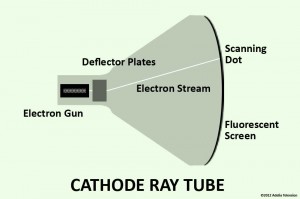FRAME RATES – NTSC VS. PAL
Why do America and Japan have different television standards to Europe? The differences are mainly down to frame rates and are historic. Here is a brief, and hopefully simplified explanation…
The British color television standard is know as PAL (phase alternating line) while the American standard is known as NTSC (National Television System Committee). Their frame rates (in fps; frames per second) are:
- PAL: 25fps
- NTSC: 29.97fps
- Film: 24fps
These figures make is seem as though PAL and film frame rates are very similar – only one frame per second difference. However, television has historically always been an ‘interlaced’ picture:
Very briefly, when television was invented in England the engineers needed a system to be able to accurately time the frame rate at transmission and reception.
I’ve always used a historical explanation of how this works that makes perfect sense. However, when checking this article with my father (ex-BBC transmission engineer for 27 years) he pointed out that my explanation was only true for Baird’s original mechanical television tests! The correct explanation he sent, is however, a little more complicated:
“Since the mid-1930s it has been standard practice to use a field frequency locked to the AC mains electric supply frequency – 50 Hz in most countries (60 Hz in the Americas) because studio lighting generally uses alternating current lamps and if these were not synchronized with the field frequency, an unwelcome strobe effect could appear on TV pictures. Secondly the smoothing (filtering) of power supply circuits in early TV receivers was rather poor and ripple superimposed on the DC could cause visual interference. However, the main problem was the susceptibility of the electron beam in the CRT being deflected by stray magnetic fields from nearby transformers or motors. If the picture was locked to the mains frequency, this interference would at least be static on the screen and thus relatively unnoticeable.” Feel free to thank my Dad for his contribution by dropping by his website
So the broadcast engineers realised that they would need a frame rate that either matched, or was a multiple of the mains electricity frequency. They also knew that to get smooth movement on screen they needed to at least match the cinema frame rate of 24fps – therefore it made sense to halve 50hz and use 25fps. Until LCD screens became popular, CRT TV’s used a single dot to scan each line of the signal onto the fluorescent screen:
As per the diagram above the television screen was made out of a vacuum tube made of glass with an electron gun at one end and fluorescent coating at the other end. When the electron stream hits the fluorescent coating the individual points glow for a few nanoseconds and as the gun scans the entire screen very quickly it appears to the human eye that it happens instantaneously.
To fit all the picture information necessary into a 50th of a second they decided to scan alternate lines every 50th of a second instead. Therefore the PAL picture is in fact made up of 50 interlaced half scans of the screen as shown by the incomplete half scan of the lion above. That is where the interlaced signal comes from and why PAL is known as phase alternating line. One result of this is that the motion between frames is much smoother – when shooting on a film camera at 24fps there is a visible stutter on medium speed camera movements which directors have to avoid. But, with video shot at 25i fps and there is no such problems as it is in fact 50 half interlaced fps…
In America the mains electricity was standardised at 60hz for historical reasons and therefore NTSC used 60hz as its timebase. So how did NTSC end up with 29.97fps instead of 30fps? Well, instead of using a multiplication factor of 1 as in the British 625 line system they decided to scan 1.001 of the screen 30 times a second so ending up with 29.97frames scanned per second – bizarre, but I’m sure there are engineering reasons…
The problem with developing standards is that everything has to stick to that standard to remain compatible. So, America was stuck with NTSC and Europe with PAL right up until HD video came along. As HD meant a complete reworking of transmission and reception equipment it became obvious that we could leave behind the limitations of the old systems that were hideously outdated. Also flat screens no longer use a single dot to scan a fluorescent surface but instead every pixel lights up at once simultaneously. This means that the scanned interlaced signal could be left behind for good. However, early progressive TV’s and cameras suffered from the same ‘stutter’ film cameras do when the camera moves at certain speeds. This was due to their standard of 25p – 25fps progressively updated. Therefore, the preferred standards are now 50p in Europe and 60p in America. We have had to stick with the differing fps standards as a European camera in America will record a flicker under flourescent lights and vice versa. However, modern televisions can display either standard.
The only annoyance is that a lot of cheaper camcorders are only available in the 30/60fps standard. This is fine if you can edit the footage using the same frame rate but there is no easy way of mixing it with 25/50fps footage as neither format is easy to convert to the other…
1 Comment
Leave a comment
Categories
Tutorials
Or maybe, wanting to jog your memory on a few key points?
Well here in Tutorials we'll walk you through how to consistently capture professional quality video whatever camera you are holding.
Start at the top - these posts are sorted for you to work through from top to bottom...








“… they decided to scan 1.001 of the screen 30 times a second so ending up with 29.97frames scanned per second…”
That would give you 30.03. I’d put “1000/1001 of the screen”.